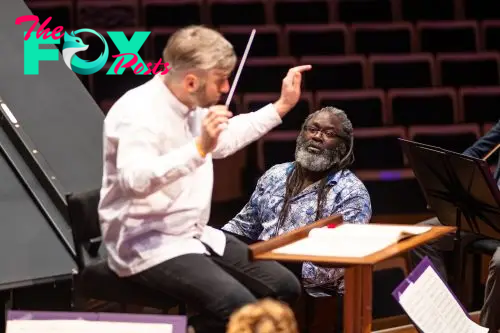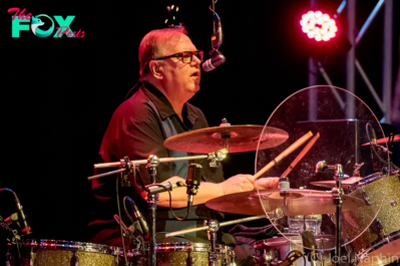Entertainment
Bruckner from the Bournemouth Symphony Orchestra – Seen and Heard Worldwide
 United Kingdom Mozart, Bruckner: Awadagin Pratt (piano), Bournemouth Symphony Orchestra / Kirill Karabits (conductor). The Lighthouse, Poole, 13.3.2024. (CK)
United Kingdom Mozart, Bruckner: Awadagin Pratt (piano), Bournemouth Symphony Orchestra / Kirill Karabits (conductor). The Lighthouse, Poole, 13.3.2024. (CK)

Mozart – Piano Concerto No.23 in A significant, K488
Bruckner – Symphony No.5
It was good to see Kirill Karabits in his fifteenth and last season on the helm of the Bournemouth Symphony Orchestra. They’ve lengthy been an excellent partnership; and the identical may be mentioned for the music of Mozart and Bruckner, paired usually and efficiently in concert events corresponding to this.
Approaching together with his dreadlocks and his coat of many colors, African-American pianist Awadagin Pratt imparted a measure of K488’s relaxed, joyful excessive spirits earlier than enjoying a observe of it. There was a lot to take pleasure in in his enjoying – his operating scales a selected delight – however there was additionally a need of delicacy and lightness of contact: it was laborious to know whether or not this was attributable to the piano, the acoustic or the pianist. The acoustic sounded reasonably boomy for a small band; Pratt’s enjoying generally appeared reasonably unvarying in phrasing and dynamics. He confirmed a stunning, ruminative contact within the unaccompanied opening of the Adagio, and the finale went with an irresistible swing: the joyously effervescent bassoon caught the ear and made me remorse that the woodwind – who’ve such pretty work on this, as in all of the Mozart concertos – had been hidden behind the piano. As Andrew Burn commented in his glorious on-line pre-concert speak, these fortunate sufficient to have heard Mozart play within the first efficiency should have gone house buzzing. Regardless of some heaviness of (left) hand in Pratt’s enjoying it was a efficiency to take pleasure in, but in addition to bolster the case for performing the work on a fortepiano.
His encore – pleasant, confined to the decrease half of the piano’s vary, and in Pratt’s fingers leaning in direction of mush reasonably than scintillation – had me foxed: my Bruckner-loving buddy Tim reckoned it was Bach, however he knowledgeable me this morning that it was Les Baricades Mistérieuses from the Sixième Ordre of François Couperin’s Second E book of Pièces de clavecin. Sounds fantastic on a harpsichord, Tim says. For somebody like me with a sketchy information of French Baroque (that’s placing it politely) he’s a useful buddy to have.
Bruckner’s Fifth was a courageous selection. It lacks the burnished glow, the Romantic glamour and the melodic attractiveness of the Fourth and Seventh, the visionary grandeur of the Eighth and Ninth: beside them, its musical cloth sounds reasonably gaunt, angular, even (at instances) threadbare. However, that is Bruckner’s goal-directed symphony par excellence: it requires persistence, the going is usually thorny and stony, however it culminates in an awe-inspiring finale which is each logically satisfying and bodily overwhelming. Karabits’s lengthy stillness earlier than the primary motion, and once more earlier than the finale, clearly signalled the magnitude of the duty forward of him and the orchestra; and it gave us, the viewers, the chance to breathe extra deeply, to regulate ourselves to Bruckner-time. My pocket book and pen, intermittently busy throughout the Mozart, lay undisturbed on my lap for the total seventy-five minutes.
Karabits performed the symphony with ardour and conviction, hewing out these colossal blocks of sound with out hurry and with out stint: the orchestra responded with enjoying of uNFLashy purity and energy. Regardless of its massiveness Bruckner’s music is commonly flecked with telling element: the flutes strolling gently above the return of the primary motion’s introduction (their quavers ‘droplets like falling tears’, as Burn put it); the lonely oboe that wanders in a wasteland on the opening of the gradual motion; the cheeky clarinet that gatecrashes the hushed and solemn opening of the finale with a preview of the principle theme. The ear was drawn repeatedly by unobtrusive phrases quietly touched in by principal horn and trumPet. The massive moments – the sonorous heat of the gradual motion’s second topic, the partaking Ländler within the Scherzo, the sudden bloom of the chorale within the finale – sounded fantastic while remaining absolutely built-in within the music’s progress.
‘Built-in’ is maybe the unsuitable phrase. A Bruckner symphony wherein the primary three actions – round 50 minutes’ enjoying time – can not completely shake off their tentative, fragmented, dislocated character isn’t going to be as standard as people who allure the listener from their magical opening tremolo. Although there are stretches of the mighty double fugue that may sound tutorial reasonably than impressed, the finale’s the factor: from the expectant recollections of the sooner actions (as in Beethoven’s Ninth – reculer pour mieux sauter) to the super return of the primary motion’s first topic we’re swept alongside on the tide of Bruckner’s invention. Overwhelmed as I used to be, a part of my thoughts reached out in sympathy to the Gamers – the brass fortissimos ringing on and on, the strings at full stretch, like so many galley slaves (as one critic put it): they should have been totally exhausted by the tip. And what an finish!
It was not till the Seventh Symphony that Bruckner started doubling the horns (the additional quartet doubling on Wagner tubas). I want he had doubled them within the Fifth: he writes splendidly for the horns within the finale, and there are locations the place they have to be heard above the wall of sound from the trumPets, trombones and tuba. Bruckner’s well-meaning buddy Franz Schalk has earned posterity’s opprobrium for throwing in an additional brass band on the symphony’s finish (although I imagine Herbert von Karajan did one thing of the type when he carried out the work in London); with out going to date excessive, Bernard Haitink (with the Vienna Philharmonic within the Royal Pageant Corridor) and Günter Wand (in a televised Promenade with the BBC Symphony Orchestra) each added a pair of horns to the quantity prescribed within the rating, to good impact (Haitink, equally efficiently, added a second timpanist). To listen to how the horns ought to sound I like to recommend listening to Jascha Horenstein’s 1971 BBC Promenade efficiency, obtainable on BBC Legends, a efficiency I used to be lucky to attend.
I had questioned how Bruckner would sound in The Lighthouse: it was a nice shock to listen to how nicely the corridor coped with it (and the way nicely, maybe, the orchestra tempered their enjoying to the acoustic). Bruckner’s music doesn’t all the time work nicely on London’s Southbank, however it definitely works in Poole.
Chris Kettle
-

 Entertainment8h ago
Entertainment8h agoBeyonce to Headline Halftime Show During NFL Christmas Game
-

 Entertainment10h ago
Entertainment10h agoDid You Correctly Answer This Poughkeepsie Related Jeopardy Question?
-

 Entertainment14h ago
Entertainment14h agoWhat to Know About Denzel Washington’s Gladiator II Character
-

 Entertainment15h ago
Entertainment15h agoChanges Made in New York to “Men Working” Construction Signs
-

 Entertainment1d ago
Entertainment1d agoRemembering Song Jae-rim: A Look at His Best Movies and K-Drama Performances
-

 Entertainment1d ago
Entertainment1d agoAmerica On CoffeeWe’re simply inviting you to take a timeout into the rhythmic ambiance of our breakfast, brunch and/or espresso alternatives. We’re pleased everytime you cease by.SELF CONTROL
-

 Entertainment1d ago
Entertainment1d agoOrange County Choppers Is Ready For Its Big Comeback
-

 Entertainment1d ago
Entertainment1d agoThe Real Story of Geta and Caracalla, the Roman Brother Emperors in Gladiator II
























